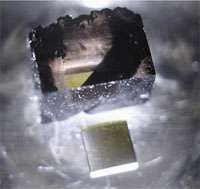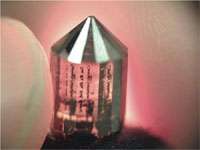Researchers find way to produce very large diamonds very fast

Washington, D.C. Researchers at the Carnegie Institution's Geophysical Laboratory have learned to produce 10-carat, half-inch thick single-crystal diamonds at rapid growth rates (100 micrometers per hour) using a chemical vapor deposition (CVD) process. This size is approximately five times that of commercially available diamonds produced by the standard high-pressure/high-temperature (HPHT) method and other CVD techniques. In addition, the team has made colorless single-crystal diamonds, transparent from the ultraviolet to infrared wavelengths with their CVD process.
Figure 1. The variety of single crystal diamonds produced by the Carnegie high-growth rate CVD process.
"High-quality crystals over 3 carats are very difficult to produce using the conventional approach," commented Dr. Russell Hemley who leads the diamond effort at Carnegie. "Several groups have begun to grow diamond single crystals by CVD, but large, colorless, and flawless ones remain a challenge. Our fabrication of 10-carat, half-inch, CVD diamonds is a major breakthrough." The results were reported at the 10th International Conference on New Diamond Science and Technology, Tsukuba, Japan, on May 12, and will be reported at the Applied Diamond Congress in Argonne, Illinois, May 18.
Most HPHT synthetic diamond is yellow and most CVD diamond is brown, limiting their optical applications. Colorless diamonds are costly to produce and so far those reported are small. This situation limits general applications of these diamonds as gems, in optics, and in scientific research. Last year, the Carnegie researchers found that HPHT annealing enhances not only the optical properties of some CVD diamond, but also the hardness [1]. Using new techniques, the Carnegie scientists have now produced transparent diamond using a CVD method without HPHT annealing (Fig. 1).

To further increase the size of the crystals, the Carnegie researchers grew gem-quality diamonds sequentially on the 6 faces of a substrate diamond plate with the CVD process (Fig. 2). By this method, three-dimensional growth of colorless single-crystal diamond in the inch-range (~300 carat) is achievable.

Finally, new shapes have been fabricated with the blocks of the CVD single crystals. Figure 3 shows a 12-millimeter anvil that can be used for new types of scientific experiments.
The standard growth rate is 100 micrometers per hour for the Carnegie process, but growth rates in excess of 300 micrometers per hour have been reached, and 1 millimeter per hour may be possible. With the colorless diamond produced at ever higher growth rate and low cost, large blocks of diamond should be available for a variety of applications. "The diamond age is upon us," concluded Hemley.
Source: Carnegie Institution















